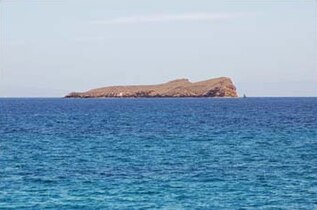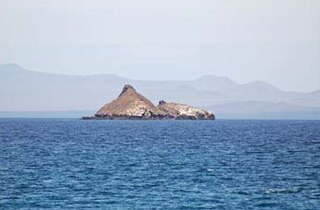Isla Guy Fawkes
0°30′55.69″S 90°31′37.90″W / 0.5154694°S 90.5271944°W / -0.5154694; -90.5271944
Guy Fawkes Island (Spanish: Isla Guy Fawkes), properly the Guy Fawkes Islands (Islas Guy Fawkes), is an island group composed of two crescent-shaped islets—North Guy Fawkes I. (I. Guy Fawkes Norte) and South Guy Fawkes I. (I. Guy Fawkes Sud)—and two rocks located northwest of Santa Cruz Island in the Galápagos Archipelago in Ecuador.[1] The group is uninhabited but sometimes visited by scuba divers.[2]
William Beebe visited the islands and makes mention of them in his book Galapagos: World's End. He described the cliffs—made of stratified layers of volcanic tuff—as majestic and also noted a population of sea lions.[3]
The island is perhaps best known for its name, honoring the English Catholic revolutionary Guy Fawkes, who attempted to blow up Parliament in 1605.[4][5]
Gallery
-
 North Guy Fawkes Island from the direction of Santa Cruz
North Guy Fawkes Island from the direction of Santa Cruz -
 South Guy Fawkes Island from the direction of Santa Cruz
South Guy Fawkes Island from the direction of Santa Cruz
References
Citations
- ^ "Topography and Landforms of Ecuador" (PDF). Geology.er.usgs.gov. 24 October 2007. Archived from the original (PDF) on 16 February 2008.
- ^ "Islas Galápagos Underwater Photography Gallery". RamblinCameras.com. 24 October 2007.
- ^ Beebe & al. (1988).
- ^ "Island Names and Their Derivations". Galapagos.to. 24 October 2007. Archived from the original on 9 November 2007.
- ^ "Transplanted Englishman brings countryís Guy Fawkes party tradition to Burnsville". ThisWeek-Online.com. 24 October 2007.
Bibliography
- Beebe, Charles William; et al. (1988), Galápagos: World's End, Mineola: Dover Publications, ISBN 978-0-486-25642-9.
External links
- Satellite view of Isla Guy Fawkes
- v
- t
- e
- Baltra Island (S. Seymour)
- Bartolomé Island
- Darwin Island (Culpepper)
- Española Island (Hood)
- Fernandina Island (Narborough)
- Floreana Island (Charles)
- Genovesa Island (Tower)
- Isabela Island (Albemarle)
- Marchena Island (Bindloe)
- North Seymour Island
- Pinzón Island (Duncan)
- Pinta Island (Abingdon)
- Rábida Island (Jervis)
- San Cristóbal Island (Chatham)
- Santa Cruz Island (Indefatigable)
- Santa Fe Island (Barrington)
- Santiago Island (James)
- Wolf Island (Wenman)
- Daphne Major
- Isla Guy Fawkes
- Nameless Island
- Roca Redonda
- South Plaza Island
- Alcedo Volcano
- Cerro Azul
- Cerro Pajas
- La Cumbre
- Daphne Major
- Volcán Ecuador
- Roca Redonda
- Sierra Negra
- Volcán Wolf
 | This Ecuador location article is a stub. You can help Wikipedia by expanding it. |
- v
- t
- e














